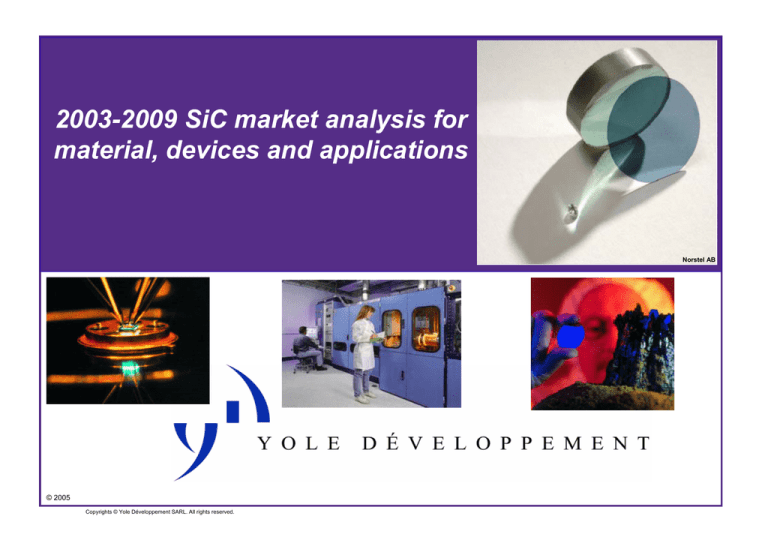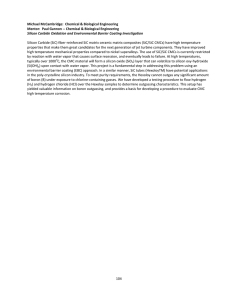
2003-2009 SiC market analysis for
material, devices and applications
Norstel AB
© 2005
Copyrights © Yole Développement SARL. All rights reserved.
Content
•
•
•
•
Applications roadmap
New players on the market place
Status of SiC market in 2004 and 2009 projection
Focus on power electronics
– Schottky diode business
– Automotive applications
• Opto business: SiC vs. sapphire
• SiC material status
• CREE and conclusion
© 2005 •
2
Copyrights © Yole Développement SARL. All rights reserved.
SiC-based applications roadmap
SiC electronics in power
distribution networks
SiC electronics in rail traction
SiC electronics in EV, HEV & FCV cars
SiC electronics in industry
SiC MESFET in 3G ,WiMax, SatCom & defense RF systems
SiC Schottky diodes in Power Factor Correctors for power supplies
HB-LEDs GaN/SiC for lightning
2004
© 2005 •
3
2005
Copyrights © Yole Développement SARL. All rights reserved.
2006
2007
2008
SiC roadmap
2009
2015
Who’s new on the market place since 2003 ?
•
Companies:
– Bridgestone (J). They are using their expertise in SiC powder and poly-crystal
substrates to enter in single crystal SiC manufacturing. They have demonstrated 6H
polytype.
– NeoSemiTech (Korea) has entered in SiC single crystal business
– CR Semiconductor Wafer & Chips (China) is launching developments in SiC Schottky
barrier diodes
– IntrinSiC (US), who has acquired Bandgap Technologies, Inc., proposing silicon carbide
wafer products.
– Okmetic that turns into Norstel (SW), still focusing on HT-CVD grown SiC material.
•
New start-up:
– Caracal Inc. (US, Pittsburg), hold by Dr. Olle Kordina -> SiC power devices (new gasbased technique epi solution using HCl as an additive, : growth rate x 3: 28µm/h) and
SiC material
– GeneSiC Semiconductor Inc. (US, Maryland), hold by Dr. Ranbir Singh -> SiC devices for
ultra-high voltage applications (MOSFETs, IGBTs, Thyristors, …). Under contract with
Darpa.
– TranSiC (SW), funded in 2005, will bring power bipolar transistors to the market during
2006.Pr. Mikael Östling, entrepreneur Bo Hammarlund and Martin Domeij Ph D and
researcher at KTH are the three founders
© 2005 •
4
Copyrights © Yole Développement SARL. All rights reserved.
SiC new players
Status of SiC-based devices in 2004
and 2009 projection
2004 Market
status
2004 SiC wafers
consumption
(2” eq.)
Players on
the market
place
Challengers
2009 market
forecast
© 2005 •
5
HB-LED
GaN/SiC
Schottky diode
MESFET
MOSFET / JFET
PiN diode
BJT /
Thyristor
$540M
In Production
$11.7M
Pre-prod.
~ 1$M
MOSFET:R&D.
Pre-prod in 2008
JFET: emerging
R&D. Preprod in 2008
R&D
320,000 x 2”
13,000 x 2”
< 500 x 2”
R&D level
R&D level
R&D level
n/a
n/a
n/a
Cree: $240M
Osram
Infineon
Cree
Rockwell
Rohm
Cree: < $1M
Rockwell
New Japan Radio
Northrop Grumman
SemiSouth
IntrinSiC
No new company
STM
Int. Rectifier
GE
Toshiba
Mitsubishi
SemiSouth
Dynex
EcoTron
Fuji
> $800M
depending on
Osram involvement
in SiC-based LEDs
Copyrights © Yole Développement SARL. All rights reserved.
~$45M for PFC
+
growing curve for
others apps.
SiCed
Toshiba
Mitsubishi
Philips
Denso
Rohm
Fuji
Sumitomo
Rockwell
United SiC
Could be > $80M
Market to start
depending on SiC vs.
GaN competition on
3G & WiMax business
depending on HEV &
EV market volume
and SiC use in cars
SiC market segmentation
SiCed
Cree
GE
Rockwell
Kansai Electric
GE
Cree
United SiC
PowerSiCel
> $10M
mainly In
industry and
power
distribution
Emerging
TAM~ $200M /
year
SiC: from material to device to market:
Focus on electronic applications
Semi-insulating
Semi-insulating
SiC
SiC
Conductive
ConductiveSiC
SiC
Rectifiers
Rectifiers
Bipolar
Bipolar
diodes
diodes
Schottky
Schottky
diodes
diodes
PiN
PiN
>>22kV
kV
© 2005 •
6
Switches
Switches
Unipolar
Unipolar
transistors
transistors
MOSFET
MOSFET
0.3
0.3->
->1.2
1.2kV
kV
Copyrights © Yole Développement SARL. All rights reserved.
JFET
JFET
0.3
0.3->
->1.2
1.2kV
kV
Bipolar
Bipolar
transistors
transistors
BJT
BJT
Thyristor
Thyristor
(GTO)
(GTO)
>>22kV
kV
SiC
SiC
market
crystalsegmentation
growth
RF
RFtransistors
transistors
MESFET
MESFET
RF
RF/ /HF
HF
SiC devices:
Power electronics market
© 2005
Copyrights © Yole Développement SARL. All rights reserved.
Power electronics
SiC power electronic devices:
Market status: small but promising…
• Reality of the market in 2005:
– As in 2003, only one component, Schottky diode (SBD),
has reached the commercialization stage and met the
market requirements.
– The applicative market is the PFC (Power Factor
Correctors) for high-end power supplies.
– 3 main players are active on this segment: Infineon, Cree
and Rockwell.
– 2005 revenues for this segment will reach $17.6M at device
level
• We forecast this market will handle 6.5 million units of Schottky
devices in 2005.
• The related wafers consumption should reach about 13,000
substrates (2”+3”). Transition to 3” wafer is now a clear trend.
© 2005 •
8
Copyrights © Yole Développement SARL. All rights reserved.
Power electronics
SiC power electronic devices:
Market status: small but promising…
•
•
This market level is not big enough to sustain the activity of many other
companies!! ...
….. But future can be brighter:
– With Schottky ASP reduction down to ~$0.2/amp, the potential market can be
extended to mid and even low-end applications using PFC: a ~$45M market is
viewed in 2009 for SBD with a related 35,000 wafers consumption.
– Automotive manufacturers are more and more involved with SiC devices to
develop efficient hybrid or full electric cars. Coupled with high power density
silicon transistors, it will help to decrease power loses and system size/weigh
in inverters and converters. Next step will be the emergence of reliable SiC
transistors to provide a full-SiC solution. But:
• EV or HEV market is slowly emerging. Big volumes are linked to oil price, ecological
behavior and governmental financial incentives
• Silicon is still on the run to compete in high power density field. Trench MOSFET
technology is a pertinent candidate to take market share over SiC future transistors.
– Other applications are expected improvements thanks to SiC devices:
• Defense, rail traction, industry, electrical power distribution network, …
© 2005 •
9
Copyrights © Yole Développement SARL. All rights reserved.
Power electronics
SiC Schottky Barrier Diode (SBD)
Device and related markets
© 2005
Copyrights © Yole Développement SARL. All rights reserved.
Power electronics: Schottky
SiC Schottky diodes
2004 market status
In terms of components using SiC hetero-structures as active layers, the
most advanced component remains SiC Schottky diodes. This component
is at a production level and we estimate that ~4 million Schottky diodes
have been produced in 2004.
Today, only 3 companies are producing such a component:
• Cree (US)
• Infineon (D): Epi and R&D made by SiCed (Erlangen, D) and chips made in
Infineon 3’’ fab in Villach (Au). Customers example: Lambda (NV series
power supplies).
•Rockwell (US).
Rohm (J) should have been entered in Schottky business spring 2004. Others
companies like Fuji (J), Hitachi (J), International Rectifier (I), Matsushita (J), STM (I),
Toshiba (J), EcoTron (J), CSWC (C) have a strong R&D related to process Schottky
diodes but have no entered in a production stage yet.
© 2005 •
11
Copyrights © Yole Développement SARL. All rights reserved.
Power electronics: Schottky
SiC Schottky diodes
Devices specs roadmap
2005
10A/1200V
2007
40A/1200V
2009
100A/1200V
• Roadmap is given for single chip device
• This evolution is linked to the improvement of useable area, and so to micropipes
density
• A 100A diode will need about 10x10 mm² micropipe-free active area. 1200 V breakdown
voltage requires about 12-15 µm epilayer thickness.
• It’s now all a question of material ! …. and cost….
© 2005 •
12
Copyrights © Yole Développement SARL. All rights reserved.
Power electronics: Schottky
SiC Schottky diodes market forecasts
30 000 000
60
SiC Schottky diodes market forecasts
25 000 000
50
20 000 000
40
15 000 000
30
10 000 000
20
0.5$ / Amp
5 000 000
10
0
0
2003
2004
2005
2006
2007
2008
2009
Cree shows $3 M revenues on Schottky business in 2004
© 2005 •
13
Copyrights © Yole Développement SARL. All rights reserved.
Power electronics: Schottky
Market (M$)
Volume (units)
0.3$ / Amp
SiC devices:
Automotive applications
© 2005
Copyrights © Yole Développement SARL. All rights reserved.
Power electronics: Automotive
Why SiC in cars ?
•
•
Electronics is now accounting for more than 25% of cars cost.
Power electronics will be more and more implemented in car due to:
– The emergence of 42 volts electronics with related systems: electric steering
and breaks, X-by-wire commands, piezo fuel injectors, …
– The high market penetration of hybrid cars (HEV), electric cars (EV) and future
fuel-cells cars (FCV) over regular internal combustion engine cars (ICE).
– The need for high pressure and high temperature sensors that can benefit
from SiC hardness and robustness.
•
•
In every case, SiC can handle improved power density with lower power
losses, and will help to decrease the size and so the weight of power
drivers.
When ?
– Today, current systems are using silicon devices but weight, size, power
efficiency and limited junction T° remain an issue.
– According to car manufacturers, SiC could be implemented in large volume by
2009. SiC diodes will be the first target, followed by SiC transistor switch when
it will be ready. Use of silicon trench-gate transistor could bring a first
solution.
© 2005 •
15
Copyrights © Yole Développement SARL. All rights reserved.
Power electronics: Automotive
Automotive Application:
Hybrid Electrical Vehicle (HEV) requirements.
•
DC-DC converter
– Goal: to provide a high voltage (400V) to
12V output, with an option to provide a
42V output.
– Typical power rating: 3 to 10kW
with switching frequency of 50-100 kHz
Isolated full-bridge step-down dc-dc converter
•
Inverter (DC-AC 3-phases converter)
Typical 400 V DC
battery pack
– Goal: To develop an integrated
motor/controller comprised of the motor
and inverter in a single package. The
goals for the system include an
integrated power electronics system
capable of 15 years lifetime and capable
of delivering at least 55 kW of power for
18 sec and 30 kW continuous power.
– Up to 300 A per motor phase
– Cost < 7$/kW
© 2005 •
16
Copyrights © Yole Développement SARL. All rights reserved.
Power electronics: Automotive
Each transistor and diode has to
handle 400 V and 200 A peaks.
Three-phase inverter traction drive
Typical motor: 30 kW,
230 V, 4-pole, 3000 rpm
Sales projection for EV, HEV & FCV
to 2020 in million units
16
Forecasted annual sales of EV+HEV+FCV
(million units)
14
12
10
8
6
4
2
0
2002
2004
2006
2008
2010
2012
2014
2016
Emergence of fuel-cell based
electrical cars
© 2005 •
17
Copyrights © Yole Développement SARL. All rights reserved.
Power electronics: Automotive
Sales volume projection for SiC diodes and
transistors in automotive applications
300
Forecasts for SiC diodes & Transistors
volume in EV, HEV and FCV
250
SiC transistors need (Munits)
200
SiC diodes need (Munits)
150
100
50
0
2002
2004
2006
2008
2010
2012
2014
Based on average figure of 24 SiC diodes and 10 SiC transistors per car. SiC
market share goes from 5% in 2008 to 50% in 2016
© 2005 •
18
Copyrights © Yole Développement SARL. All rights reserved.
Power electronics: Automotive
2016
SiC / sapphire substrates volume estimation for
GaN-based LED production
Market hypothesis:
• Illumination high-volume market will not start before 2007
• SiC substrates (mainly Cree and Osram) will loose market shares, facing sapphire high
volume productions from Asia
• LED ASP will remain around 0.10$ (Emergence of new high-end products with higher ASP
facing ramping-up of low-end, large scale production LEDs with lower ASP)
3,5
Technical hypothesis:
• Production yield will
reach 85% in 2007
• 11,000 LEDs on 2”
sapphire substrate
• 16,000 LEDs on 2” SiC
substrate
Number of 2" equivalent substrates to process
for GaN-based LED production (Million units)
3,0
0,33
SiC (2")
2,5
0,32
Sapphire (2")
0,30
2,0
0,27
1,5
0,24
2,50
1,15
0,68
0,0
2001
© 2005 •
19
Copyrights © Yole Développement SARL. All rights reserved.
2,95
1,59
0,16
0,5
2,71
2,12
1,0
SiC-based LEDs represented
25 % of market in 2001 and is
now only 12 % in wafers
volume
0,36
2002
Optoelectronics
2003
2004
2005
2006
2007
From a material point of view…
Total SiC substrates market was in the $90M range in 2004.
II-VI + Norstel +
IntrinSiC +
Dow Corning +
Sixon +Nippon
Steel
+SiCrystal +
Others
30%
This figure includes the internal Cree consumption for LED
business
We consider the remaining open market to be ~$30M
Cree
70%
SiC substrates sales breakdown over
the $30M open market
© 2005 •
20
Copyrights © Yole Développement SARL. All rights reserved.
SiC Material
Cree business-model evolution and
conclusion
•
•
•
•
Fact 1: Cree was representing approximately 1/4 of wafers consumption for HBLEDs production in 2001 and that should decrease down to 10% in 2007.
Fact 2: Cree is moving to packaged LEDs business.
Fact 3: Osram, the only other SiC user for LED business, is now trying to escape
from Cree monopoly using thin-film technology on sapphire substrates.
Analysis:
– SiC is no more the “ideal” substrate for high performances LEDs: Sapphire can compete
on high-end LEDs segment (see Lumileds, Nichia, …).
– Thin-film approach allows now back-face contact possibility, like SiC does -> smaller
dies.
– Cree has to move one step ahead, to packaged LEDs, in order to benefit from larger
added-value products.
•
Conclusion:
– SiC has to find another playground to grow. Opto business is captive to Cree and the
emergence of electronic devices with related applications is the only way to make a
profitable business at material or component level.
– SiC has to fight with GaN on RF markets but is the only pertinent solution for high
power electronic market, especially for automotive, industry and power distribution.
– SiC transistor is now widely welcome...
© 2005 •
21
Copyrights © Yole Développement SARL. All rights reserved.
CREE & Conclusion
High Technology Focus
SiC material,
devices & applications
Evaluation of the 2003-2008 SiC
market and analysis of the major
technology and industrial trends
2005 edition
89 profiles
COMPONENTS
Acreo - Sweden
Advanced Power Technology - USA
Caracal - USA
Cree - USA
Denso - JP
Dynex Semiconductor - UK
Fuji Electric - JP
Fujitsu Laboratories - JP
GE Global Research Center – USA
GeneSiC Semiconductor Inc. - USA
Hitachi Research Laboratory - JP
Infineon Technologies - GER
International Rectifier - IT
Kansai Electric Power - JP
Matsushita Electric Industrial - JP
Microsemi - USA
Mitsubishi Electric - JP
NEC - JP
Nissan Motor - JP
Norse Semiconductor
Northrop Grumman - USA
Oki Electric Industry - JP
Osram Opto Semiconductors - GER
Philips Semiconductors Nijmegen - NL
Qinetiq - UK
RF Micro Devices Charlotte - USA
Rockwell Scientific - USA
Rohm - JP
Sanyo Electric Company - JP
Shindengen Electric Laboratories - JP
Siced - GER
STMicroelectronics – FR and IT
Tohoku Electric Power – JP
Toshiba – JP
Transic - SW
United Silicon Carbide - USA
EQUIPMENTS
Annealsys - FR
Epigress - SW
Linn High Therm – GER
LPE EPI – IT
MATERIALS
Bridgestone - JP
Caracal - USA
Cree - USA
Dow Corning - USA
Hoya Advanced Semiconductor Technologies
- JP
Intrinsic – USA
Neosemitech - Korea
Nippon Steel – JP
Norstel - SW
Novasic - FR
Semisouth - USA
Showa Denko - JP
SiCrystal - GER
Sixon - JP
Soitec - FR
Technologies and Devices International - USA
Tohoku Electric Power
Toshiba Ceramics, Tocera – JP
Toyota - JP
II VI - USA
MEMS
Boston Microsystems - USA
Cornell University – USA
FLX Micro - USA
Innovative Scientific Solutions - USA
Kulite - USA
Olivetti I Jet - IT
Taitech - USA
R&D CENTERS
AIST - JP
APEI - USA
Auburn University - USA
Case Western Reserve University - USA
Centro Nacional De Microelectronica - SP
Chalmers University of Technology - SW
Crhea - FR
F-A University Erlangen Nuremberg – GER
Institut für Kristallzüchtung - GER
INPG – FR
Ioffe Physico-Technical Institute - RUS
Kyoto University - JP
Linköping University - SW
Mississippi State University - USA
Nasa Glenn Research Center - USA
Purdue University - USA
Rensselaer Polytechnic Institute - USA
Rutgers University, SiCLab - USA
Texas A&M University - USA
University of Arkansas - USA
University of Newcastle - UK
University of South Calorina - USA
University of South Florida - USA
EUROPE
ACREO
ACREO AB
Electrum 236
SE-164 40 Kista
SWEDEN
Tel: +46 8 632 77 00
Fax: +46 8 750 54 30
www.acreo.se
Email: info@acreo.se
Key managers and/or contacts
Susan Savage
SiC Activity Manager
+46 8 632 7808
susan.savage@acreo.se
Company Overview
Acreo AB is a non-listed limited company. The majority of the shares are held by the Association
FMOF(Mikroelektronisk och Optisk Forskning). The minority owner is the holding company IRECO,
controlled by the Swedish Ministry of Industry and the Foundation KKS. ACREO is a result of the
merging of IOF (Institute of Optical Research) and IMC (Industrial Microelectronics Center) in 1999.
Acreo’s technical development areas are Imaging, Interconnect and Packaging, Photonics, RF and
Power Components, Microsystem Technology, Surface Characterisation and System-level Integration.
Business Services is dedicated to technology transfer and market support for small and medium-sized
companies. Semiconductor technology plays a central role in all operations.
Market and customers
Open collaboration with all kind industrial players, as Volvo, Ford, Vattenfall or AppliedSensor.
As a laboratory, they offer technologies, not products.
Agreements and Alliances
Partners
University of Linköping
Partnership type
Swedish centre for Sensor Development at
ACREO
2
Mecel in Åmål
Volvo in Göteborg
Vattenfall
AppliedSensor
Hoya Advanced
(HAST)
Linköping university (S-SENCE) : R&D on
SiC gas sensor
Semiconductor
Technology R&D collaboration
Financial data
Investors and/or parent company
% of
shares
FMOF
IRECO AB
60%
40%
Spin off
AMDS - Advanced Microwave Device Solutions
AMDS - Advanced Microwave Device Solutions - is a spin-off company from Acreo launched at the
end of 2001 in order to exploit the development of SiC RF components that has been on-going at
Acreo since 1997. It has been sold to Intrinsic Inc in 2004.
In € million
Total sales
Employees
2003
22,2MSEK
169
2004
21,2MSEK
160
2005 (est.)
156
In 2004, Acre revenues coming from industrial partners accounted for approximately 44%
Main Products
SiC Gas sensor :
Acreo had worked together with the Swedish centre for Sensor Development at Linköping university
(S-SENCE) to develop gas sensors based on the semiconductor material SiC. The collaboration has
resulted in a proprietary design based on a MOSFET type component using a catalytic metal as the
active gate contact. S-SENCE have made detailed studies of the gas sensing capability of different
catalytic metals while Acreo have been responsible for the high temperature MOSFET design.
The silicon carbide based sensors, MISiC sensors, can be operated at temperatures up to 700° C and
have the advantage of being chemically very inert.
These sensors are developed in a project with Volvo in Göteborg and Ford in Dearborne, Michigan,
USA to control the SCR, Selective Catalytic Reduction, process, where NO and NO2 are reduced by
NH3 in the catalytic converter to nitrogen and water. NH3 is injected into the exhaust gases as urea
dissolved in water, which forms NH3 and CO2. According to industry partners, this method will have to
be used to fulfill the much stricter legislations for NOx emissions, which are valid from year 2007.



